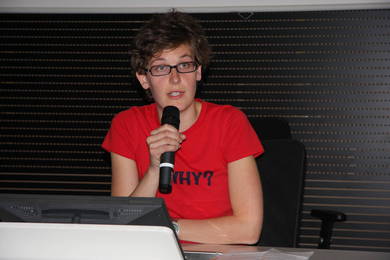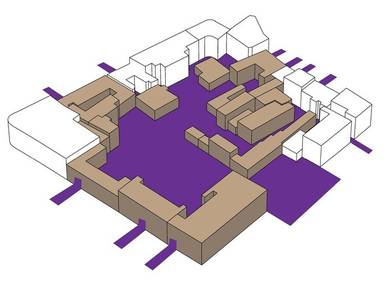Theatre Closer to the Public
The winning project in the ‘The New Theatre for the 21st Century’ competition was presented by the authors themselves. The winners are a five-member team of students from the Faculty of Architecture at the University of Ljubljana named: Alen Hausmeister, Mina Hiršman, Aleš Kacin, Jana Kocjan and Katja Ložar. The presentation of project took place just prior to a seminar ‘Thinking the Space’ and on this occasion we had an opportunity to interview them. We talked about the contest, working as a team, travel, and plans for the future.
Why did you participate in the TACE student workshop and competition ‘The New Theatre for the 21st Century’? What did you find interesting about it?
This workshop was not spoken about a lot at our school, we only saw a poster in the school a day before the workshop started and our professor reminded us as well. Thinking about theatre space sounded interesting. We participated, although it was extra work for all of us, since we were all working on many other projects already. And as a matter of fact, we didn’t even know this was a competition. We were therefore not exposed to any kind of stress, and the news about the winning project was a big surprise.
How would you define your project? What are the keynotes of the project?
Our project, or our work, was mainly based on discussion. Not so much a discussion of what a theatre should look like, but what a theatre today actually is. So we made investigations into contemporary theatre and the history of theatre. We wanted to see what kind of space is needed for theatre today and we realized that we can’t really say: today we need this kind of theatre or this kind of stage, because a theatre is changing all the time. It is even hard to talk about a revolution in theatre the way we can for instance in the previous century. Besides, there are so many factors on which a theatre depends – and they are all different: directors with different ideas, different actors, and different stages. It is therefore difficult to say: we have to make a theatre like this, although there are some technical rules we must follow of course. We wanted to make a theatre appropriate for all kinds of approaches. We realised that the site we were given actually offers all these kinds of possibilities. Our idea was not a theatre on a location but a creation of a theatre space out of a location.
You designed the project together with the rest of your five-member team. What was it like? Was it your first cooperative effort? Did you have similar working methods and opinions?
We were a team of five students in different semesters (6th – 9th semesters and one student working on diploma thesis). It was a good team because we all took different approaches to the project and we combined them quite well together – the 6th-semester students normally work a lot on analyses (which was great, because we came to some very important facts about the site), while older students normally work faster on the concept and the presentation and the realisation of the idea.
Although we knew each other well, since we work on the same seminar, we had never worked together on project. We must say it was very successful.
What are the advantages of teamwork? Could you recommend any to others?
It is very important, because it helps each member of a team to see things from another perspective. Someone might see a direction that you couldn’t see yourself, and this contributes a lot to a project.
As a student you often work alone on a project and you think that what you think is right, or what your mentor thinks is right, but as an architect you have to make a lot of compromises – you never work alone on a project and that’s why it is important to learn to work with others.
How would you describe the genesis of your project? Did you make considerable changes to the project? Was it clear from the very beginning?
One idea was clear from the beginning – we tried not necessarily to create a big building, or an icon, which many people think a theatre should be. This might perhaps be visible in all the other participating projects – creating a theatre building whose appearance everyone can discuss. But honestly, the big buildings we still talk about were built many years ago. Today everything goes so fast and this also influences architecture. That’s why it’s hard to create a building that will leave a long-lasting impression. We therefore thought of an approach that is gentler and gives perhaps something more than just an impression of a huge building. Ljubljana is a nice, but small city. Perhaps it is nice because it lacks huge buildings. Once we get one big building, we’ll soon have a hundred. And Ljubljana will lose something very specific.
But throughout work on the project we discussed all those different relationships between an actor and an observer. We discussed this while we discussed the site and this was very helpful – a lot of ideas came from the site, which offers so many possibilities.
At the same time we were much concerned with how to bring the theatre closer to people – we can’t avoid the fact that there are many people who don’t go to the theatre. That’s why we were very concerned about the public space of a theatre. This is the reason why we received some criticism of our project – that this kind of theatre is too ‘rural’, or that we only thought of street theatre performances. We could agree with these criticisms if we hadn’t been thinking of creating a theatre with good technical support as well – this was put underground. Basically we made a theatre the way everybody else did, or as it should be in terms of technical demands, but we put it under ground in order to take advantage of the site we were given. This site is very special – it is full of some hidden courtyards and passages, it perhaps imparts a Mediterranean feeling... Why shouldn’t we show this association by using the site as a big public ground while putting the main stages underground?
What do you consider the necessary attributes of good architecture?
A concept is a very important thing. If it’s bad or wrong the whole work might get very complicated and in the end it looks wrong. It’s also hard to work if you don’t have an idea or an aim as to what you want to do. But sometimes you have all this, and still the result is bad, or at least not as successful as you wanted it to be, if you misunderstood the context. The context might therefore even be more important than a concept.
Good architecture is a sum of many things – sometimes you also need some luck so that all the factors that influence the result come successfully together. Unfortunately, one needs to make a lot of compromises when working in the architecture business. That’s not something we learn as students – for a student a good concept is everything. But when you are an architect you realise that there are many obstacles you meet when you want to realise your concept. You can easily end up creating the very poor and cheap works that the fast-growing market wants from you. As an architect you have to know how to get around these obstacles and get the best out of your compromises.
But in the end you still need to be aware of your concept and hope that it’s clear in the architecture. As an architect you never stand next to your building explaining what you meant by creating it this way.
One problem with architecture is also that many times the awarded buildings were awarded by architects, but not recognised as good by other people. Probably the most successful thing is when both sides agree it is good.
Do you have any favourite theatre building in the world?
Every theatre has its specifics and might be good because of them. The Opera in Sydney is a masterpiece from the previous century and it’s mostly known as a symbol of Australia. A good and thoughtful example concerning the space is also the philharmonic in Berlin by Hans Scharoun. One successful example is also the opera in Oslo. It is good in its technical aspects, but the inner space is actually nothing really special. The most important thing by this opera is the successful creation of public ground in front of the entrance. People really like it and go there often, it is also very popular among tourists.
How important is travelling for your work?
As a student of architecture you should experience things not only by looking at magazines, but travelling and really seeing the architecture you learn about. At the same time it is not only architecture, but many other things you learn about while travelling – you get to know other cultures, languages, people, you can feel the place.
An important thing happens also when you return home from a trip – suddenly you see some things differently from how you saw them before – because you have broadened your horizons and might have changed the criteria.
Do you have any experience with this?
Studying abroad helped a lot to broaden the approach to working in architecture – some things are in this way certainly done in a different way than they’d be done without this extra experience from abroad. But this experience from abroad doesn’t only affect the working approach but the whole way of living.
How do you see your future? Are you about to cooperate, or set up your own architectural office?
… You never know. You need a lot of practice before starting up your own office. We still have at least five or ten years to go before deciding on something like that.
Maybe in the future
Well, so far our work has gone well. But in an office you are not only being creative all the time, unfortunately the majority of work is bureaucracy – this takes up perhaps some 80% of the work, 15% is working on technical drawings, and only 5% is left for creativity. Our problem right now is that we all want to be ‘the creators’. No one wants to take on the bureaucracy.
31. 5. 2010, Václav Huml






